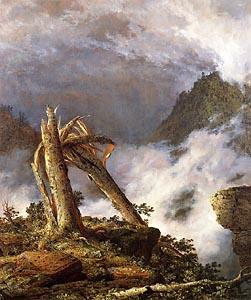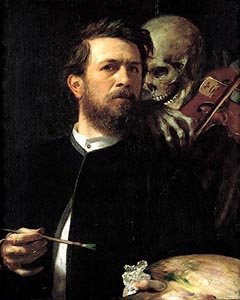| |
Boris Koller is an Austrian composer and painter.
In the early 1990's he visited Sweden and Norway, and he was drawn
to the natural beauty of the region. Many of his paintings
have been inspired by the rugged terrain of Troms county
in
northern Norway. Mr. Koller also made numerous excursions in
this area during his extended stay on the remote island of Senja in 2003-2004. The
majestic Norwegian landscapes are captured
in
his paintings by his rendering of meticulous detail and
atmospheric effects.
The history of Landscape art developed along two lines. One of
the first important artists to specialize in Landscape art was
Claude Lorrain (c1604-1682). His works
utilized the Classical formulae of the idealized
landscape and were inspirational to English artists
 John Constable
(1776-1837) and J.M.W. Turner (1775-1851).
They in turn helped bring attention to Landscapes in the first
decades of the 19th Century and influenced many European
artists, including
Camille Corot (1796-1875) and other Barbizon artists in
France. The second line also began in the 17th Century, as a landscape
art
tradition evolved in the Netherlands, with important work
being done by Jacob van Ruisdael (c.1628-1682) and his pupil
Meindert Hobbema (1638-1709) and by Aelbert
Cuyp (1620-1691). The
Dutch traditions helped
to establish Landscape art in Denmark, which in turn had heavy
influences on German Romanticism. John Constable
(1776-1837) and J.M.W. Turner (1775-1851).
They in turn helped bring attention to Landscapes in the first
decades of the 19th Century and influenced many European
artists, including
Camille Corot (1796-1875) and other Barbizon artists in
France. The second line also began in the 17th Century, as a landscape
art
tradition evolved in the Netherlands, with important work
being done by Jacob van Ruisdael (c.1628-1682) and his pupil
Meindert Hobbema (1638-1709) and by Aelbert
Cuyp (1620-1691). The
Dutch traditions helped
to establish Landscape art in Denmark, which in turn had heavy
influences on German Romanticism.
In the idealized landscape artists
included classical elements such as
a temple ruins, cemetery, or a castle. This was primarily to
satisfy the
hierarchy of genres, in order for paintings to be considered
serious art. But with the spread of Romanticism and the idea that
nature itself was a divine manifestation, the pure Landscape
began to appear. This was particularly
true in America, where the
Hudson River School rose to
prominence and soon became a significant art movement. It roots
stem from both the English traditions and from German
Romanticism. Notable
artists included Thomas Cole (1801-1848), Frederic Edwin Church
(1826-1900) and Albert Bierstadt (1830-1902).
A large number artists throughout the 19th Century dedicated
themselves to Nordic landscapes, the most notable
being the two Norwegians Johan Christian Dahl (1778-1857)
and
Hans Fredrik Gude (1925-1903).
Both were mainly
domiciled
in Germany. Dahl is often called the father of Norwegian
landscape painting, and was a close friend of
Caspar David Friedrich
. Two of Dahl's most
accomplished
students were Thomas Fearnley and
Peder Balke. Gude was both student and
professor at the Düsseldorf Academy of Art, and then later
a professor at Baden School of Art . His emphasis was on naturalism and en plein air painting.
Gude had a number of important students including
Herman August Cappelen,
Lars Hertervig,
Amaldus Nielson,
Fritz Thaulou and
Kitty Lange Kielland. Mr. Koller's work
evokes the spirit of Nordic landscape art, as displayed in the
works of many of these artists.
His paintings capture the feeling of isolation and natural wonder of the Artic North
. Click here
to visit the 19th
Century Nordic
Landscape Gallery.
Johan Christian Dahl (1778-1857)
and
Hans Fredrik Gude (1925-1903).
Both were mainly
domiciled
in Germany. Dahl is often called the father of Norwegian
landscape painting, and was a close friend of
Caspar David Friedrich
. Two of Dahl's most
accomplished
students were Thomas Fearnley and
Peder Balke. Gude was both student and
professor at the Düsseldorf Academy of Art, and then later
a professor at Baden School of Art . His emphasis was on naturalism and en plein air painting.
Gude had a number of important students including
Herman August Cappelen,
Lars Hertervig,
Amaldus Nielson,
Fritz Thaulou and
Kitty Lange Kielland. Mr. Koller's work
evokes the spirit of Nordic landscape art, as displayed in the
works of many of these artists.
His paintings capture the feeling of isolation and natural wonder of the Artic North
. Click here
to visit the 19th
Century Nordic
Landscape Gallery.
Another aspect of Boris Koller's art that emerges in his figurative works is the theme of mortality. Notably
Memento Mori
(Remember you will die) establishes the point that nature is
more powerful than humanity and will outlast all of us. The
Memento Mori theme is related to the numerous Vanitas works
seen over hundreds of
years, yet this message is never more clear. Equally poignant,
Mains Sales
(Dirty Hands)
has been inspired by Jean-Paul Sartre's play about political
intrigue and
treachery. The theme of mortality resonates often in Mr. Koller's
works, somewhat reminiscent of the art of
Caspar David Friedrich.Yet
there is even closer similarity to some of the works of
Arnold
Böcklin,
such as his iconic painting
Island of the Dead
(in several versions).
Böcklin
had been trained as a landscape painter at the
Dusseldorf
Academy. He is known for his mythological works, which connect him with the
Symbolist movement. In
many
of
Böcklin's paintings
he introduced a serene, even melancholic mood. Later, around
1800, he began incorporating the theme of death. Like
Böcklin,
Mr. Koller often muses, with serene fascination, about the realm of the
departed.
works is the theme of mortality. Notably
Memento Mori
(Remember you will die) establishes the point that nature is
more powerful than humanity and will outlast all of us. The
Memento Mori theme is related to the numerous Vanitas works
seen over hundreds of
years, yet this message is never more clear. Equally poignant,
Mains Sales
(Dirty Hands)
has been inspired by Jean-Paul Sartre's play about political
intrigue and
treachery. The theme of mortality resonates often in Mr. Koller's
works, somewhat reminiscent of the art of
Caspar David Friedrich.Yet
there is even closer similarity to some of the works of
Arnold
Böcklin,
such as his iconic painting
Island of the Dead
(in several versions).
Böcklin
had been trained as a landscape painter at the
Dusseldorf
Academy. He is known for his mythological works, which connect him with the
Symbolist movement. In
many
of
Böcklin's paintings
he introduced a serene, even melancholic mood. Later, around
1800, he began incorporating the theme of death. Like
Böcklin,
Mr. Koller often muses, with serene fascination, about the realm of the
departed.
Boris Koller's paintings
reflect on vistas of alpen Austria and coastal Norway, with an
empathy gained during intimate studies in these regions. He
has
walked in the footsteps of the many Norwegians painters who
have proceeded him. We invite you to enjoy some of his
paintings in the Monograffi Fine Art Galleries.
Boris
Koller's Gallery
Boris Koller's Web Site:
http://www.boriskoller.com/
|
|